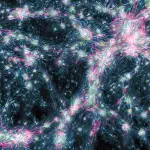Key Takeaways:
- This black hole, formed just 690 million years after the Big Bang, offers insights into how the cosmos evolved during its early stages.
- Quasars like ULAS J1342+0928 are exceptionally rare, with only one found in one-tenth of the observable sky.
- Originating from the epoch of reionization, this quasar provides a glimpse into a pivotal era when the universe transitioned from darkness to illumination.
- Further discoveries are crucial for understanding cosmic evolution, as scientists seek more early, distant quasars to unravel the universe’s mysteries.
A study has unveiled the discovery of the oldest supermassive black hole ever observed. This colossal entity expanded to 800 million times the mass of the sun during a time when the universe was merely 5 percent of its current age, as reported by researchers.
This identified immense black hole, which emerged a mere 690 million years after the Big Bang, holds promise in unraveling various cosmic mysteries. Scientists anticipate that it could provide insights into how black holes attained enormous sizes shortly after the Big Bang and how the universe transitioned from a foggy state to its current clarity.
Supermassive black holes, with masses ranging from millions to billions of times that of the sun, are believed to inhabit the cores of most, if not all, galaxies. Prior studies have indicated that these massive entities emit vast amounts of light as they consume matter, likely fueling phenomena like quasars, which rank among the brightest entities in the cosmos.
Quasars, detectable from the farthest reaches of space, stand as some of the most distant objects known to us. Moreover, the farther a quasar is, the longer its light takes to reach Earth.
The former record-holder for the most distant quasar was ULAS J1120+0641, located approximately 13.04 billion light-years away, existing roughly 750 million years post-Big Bang. Surpassing this record, the newfound quasar and its accompanying black hole, named ULAS J1342+0928, reside 13.1 billion light-years from Earth.
Understanding the Growth of Black-Hole Behemoths
Understanding how black holes amassed sufficient matter to attain supermassive proportions early in cosmic history has posed a formidable challenge. Consequently, scientists aim to study numerous early supermassive black holes to gain insights into their growth and their impact on the broader cosmos.
Lead author of the study, astrophysicist Eduardo Bañados from the Carnegie Institution for Science, highlighted the significance of the most distant quasars in addressing key questions in astrophysics.
Researchers estimate that only 20 to 100 quasars, as bright and distant as the newfound one, exist within the observable universe.
“This particular quasar’s exceptional brightness renders it an invaluable resource for follow-up investigations and serves as a critical laboratory for studying the early universe,” stated Bañados. “Observations have already been secured for this object using several of the world’s most advanced telescopes, and further revelations may emerge.”
Discovery of a Cosmic Giant
Researchers identified and examined the quasar ULAS J1342+0928 using the Magellan Telescopes at Las Campanas Observatory in Chile, alongside the Large Binocular Telescope in Arizona and the Gemini North telescope in Hawaii. Its central black hole boasts a mass approximately 800 million times that of the sun, existing when the universe was a mere 690 million years old, or merely 5 percent of its current age.
“All that mass—nearly 1 billion times the mass of the sun—must have been accumulated in less than 690 million years,” remarked Bañados. “This feat poses an extreme challenge and demands explanation within theoretical models.”
Quasars like J1342+0928 are exceedingly rare. Researchers scoured one-tenth of the entire observable sky and identified only one quasar from this early epoch.
Despite a mere 60-million-year gap between this newfound quasar and its predecessor, this time span represents roughly 10 percent of the universe’s age during those early epochs of rapid evolution. Thus, this temporal discrepancy holds potential significance in elucidating the early universe’s evolution.
This new quasar also attracts scientific interest because it originates from the epoch of reionization, a pivotal era marking the universe’s emergence from its dark ages. Bañados described it as “the universe’s last major transition and one of the current frontiers of astrophysics.”
Following the Big Bang, the universe comprised a swiftly expanding, ion-filled environment. Approximately 380,000 years later, these ions cooled and coalesced into neutral hydrogen gas. It wasn’t until gravity facilitated the formation of the first stars that the universe transitioned from darkness to illumination. The intense ultraviolet radiation from these early stars excited the previously neutral hydrogen gas, causing it to ionize and allowing light to traverse space freely.

Peering into the Early Universe
Despite significant progress, many aspects of the epoch of reionization remain shrouded in mystery, including the sources of light responsible for triggering reionization. While previous studies suggested that massive stars played a predominant role, others hinted at the significant influence of black holes.
“The timing and mechanisms of the universe’s reionization hold profound implications for its evolutionary trajectory,” Bañados emphasized.
Analysis of the new findings indicates that a considerable portion of the hydrogen surrounding the newfound quasar remains neutral. This observation suggests that the quasar originated from within the epoch of reionization, offering potential insights into the events of that crucial period.
However, a deeper understanding of the epoch of reionization necessitates the identification of additional early, distant quasars. “We must locate more quasars at similar or greater distances, although this task is exceptionally challenging due to their rarity,” Bañados concluded. “It’s akin to finding a needle in a haystack.”
Given the newfound quasar’s remarkable brightness and size, it is unlikely to be the universe’s first quasar. Thus, the quest for further discoveries continues.


